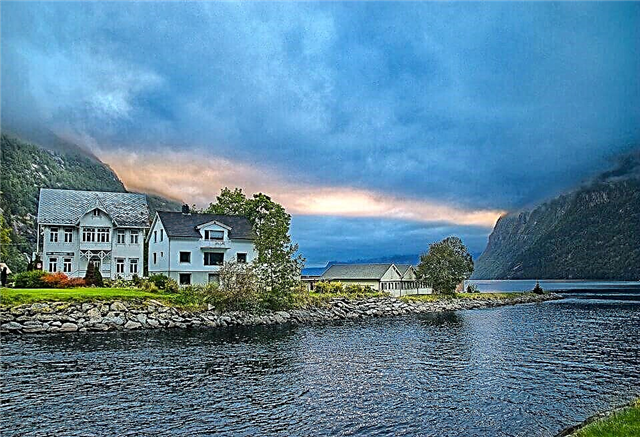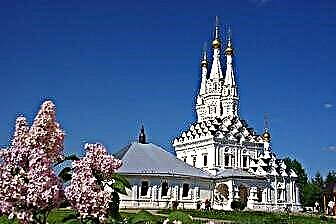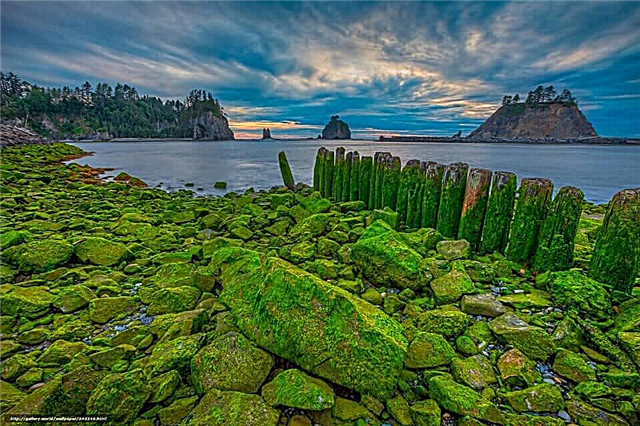When it comes to national parks in the United States, one cannot but recall the words of former President Franklin Roosevelt about the important role of such places in shaping the idea of u200b u200bthe essence of America. This is confirmed by the fact that 14 of all US national parks are UNESCO World Heritage Sites.
History

For the first time, George Kathleen spoke about the creation of special plots of land not involved in economic activity in the 19th century. As a self-taught artist, he traveled extensively in North America and watched with indignation at the harmful influence of the white man on the established traditions of the indigenous population and his unceremonious invasion of nature. Kathleen suggested the need to protect the environment and the importance of a targeted government policy aimed at creating conditions for preserving the natural beauty of the American continent.
Despite the fact that the federal government did not immediately respond to the idea of creating protected areas, in 1864, under the leadership of President Lincoln and the US Congress, the first steps were taken to create national parks.
Yellowstone

The first real national park not only in the United States, but also in the world was Yellowstone in 1872. From that moment on, the governments of other countries followed the example of the Americans. It became the starting point for the creation of 58 national parks and many other conservation areas in the 27 states of the United States. The national park is located on the territory of the three states of Idaho, Montana and Wyoming, covering an area of about 9 thousand square meters. km. The main attractions of the park are geysers and hot springs. Under the influence of various mineral salts dissolved in water, bizarre surface shapes have formed over many millions of years: pyramids, terraces and even stalactites.
Salt deposits on the earth's surface sparkle in the sun, and various metals that make up the salts paint them bright red and yellow. The slopes of the mountains are covered with coniferous forests, in which many rare animals feel great. Many clean picturesque rivers flowing from mountain ranges form numerous cascades of waterfalls. This place is considered a paradise for speleologists, and a large number of canyons attract extreme lovers here. Here, in the center of the dormant volcano Caldera, there is a high-mountainous Yellowstone Lake, the shores of which are frozen lava.
Great Smokey Mountains

The most visited park, which receives more than 9 million tourists annually, is the Great Smokey Mountains. It is worth noting that a huge influx of people wishing to taste this corner of nature is strictly regulated by the authorities so that an excessive number of visitors does not harm the fragile ecosystem of the park. It is noteworthy that the park was officially opened by US President Roosevelt in 1940. The park is located in the eastern states of Tennessee and North Carolina and covers an area of more than 2 thousand square meters. More than 4 thousand plant species are collected here - typical representatives of the flora of the eastern part of North America.
Many of them are endemic and are found only in the Great Smokey Mountains. The rich vegetation provides a favorable habitat for many of the region's fauna. There are about 65 species of mammals alone. The states of California and Alaska boast the largest number of national parks.
Sequoia Park

On the territory of California, there is the second most established park, founded in 1890. In addition to many natural objects, the famous tall trees growing in the Giant Forest occupy a special place in the Sequoia Park. It is noteworthy that five of the ten tallest trees in the world grow in this forest. Of great interest to tourists is a sequoia called General Sherman, reaching a height of more than 80 m, the base circumference of which is more than 30 m. It is not for nothing that the tree is "awarded" the rank of general. Due to the sheer volume of timber, General Sherman is the largest tree on the planet.
Denali Park

Denali National Park, located in Alaska, covers a vast territory, exceeding in size the area of Massachusetts and even many states. The word "Denali" is translated from the Athabaskan language as "great". This is how the indigenous people once called the highest peak of North America located on this territory.
The definition “great” is the best way to characterize Denali Park. The highest point of the mainland is Mount McKinley, the enormous size of the park and the endless expanses of the tundra with its inhabitants - all this confirms the enormous importance of the park in preserving the delicate balance of this natural zone of North America.
Numerous representatives of the local fauna, among which it is worth noting caribou, moose, brown bears, mountain sheep and wolves, live here as many centuries ago, freely and in complete safety.
Grand Canyon

Located in northern Arizona, this huge gorge is the largest natural attraction in the United States. Much of the grand gorge is part of the Grand Canyon National Park, covering 4,950 sq. km (length - 433 km, width - from 180 m to 28.8 km). The depth of the unique canyon is on average 1.6 km. The Grand Canyon Park area is divided by the Colorado River into 2 parts: South Rim (the most accessible to tourists) and North Rim (more remote and less visited). On the high (over 2 km) walls of the gorge, consisting of different layers of rock, one can "read" the history of earthly transformations over the millions of years of the planet's existence.
This is successfully done by geologists who determine the quality of each layer: marine sediments of the once warm sea, petrified desert sand, layers of limestone, granite, clay, shale. There are hiking trails in the park for group hikes to the sights of the amazing nature reserve. Both parts are connected by a suspension bridge across the river. Colorado. Tourists walk 34 km, including a vertical descent along the canyon walls and the same ascent to a height of 1.6 km.

Given the complexity of such extreme hikes, they are carried out with the participation of experienced guides, with the organization of overnight stays. You can travel by car through the canyon from South Rim to North Rim, covering 354 kilometers and crossing the canyon through the Navajo Bridge (122 m long). Both areas of the Grand Canyon are visited by millions of tourists, for whom all the necessary infrastructure has been created: hotels, campgrounds, restaurants, cafes have been opened. In the local village of Grand Canyon Village, there are many viewpoints and free public transport. The tourist boom is always here, with the exception of winter and late autumn.
Zion Park

Zion National Park is located among the natural beauty of Utah. The local landscapes conquer with the wild, pristine beauty inherent in the Kolob Canyon area, the most uninhabited part of the park. It is this area that is poorly equipped, and nature, largely untouched by the rampant civilization, is preserved in it. There are rugged trails that can only be walked with a guide, a few ranches with traces of abandonment. Kolob Canyon is a favorite place for rock climbers who bravely climb steep cliffs (you need to have a special pass), there is no mass influx of tourists.
Nature creates here such pictures that you will not see anywhere else: reddish-orange massifs of mountains rise above the gorges, green spots of woodland cover their slopes, in some places the whole earth is covered with a thick cover of yellow heather. Among the unusual trees, there are familiar birches that look strange against the background of red spurs.

Kolob Canyon with the rest of the Zion is connected by the same scenic red road. Tourists take walks along the bottom of the gorge along a river with a turbulent current, which in several places is so shallow that you can wade it. The river bed has many rapids that form picturesque waterfalls. There are many high waterfalls here, one of them is called “weeping rock”: rare splashes fall from a high rock on those passing under it. The mesmerizing beauty of Zion Park attracts tourists from all over the world.
Monument Valley

Monument Valley National Park, an area that has long belonged to the Navajo Indians, is a true miracle of nature, created under the influence of wind erosion. For centuries, the winds of Arizona, like the omnipotent sculptors, "carved" towers of bizarre shapes from the rocks. Painted in reddish-brown colors, they appear to be aliens descending to Earth. The Martian landscapes of the unique valley are included in the list of 100 wonders of the world, despite the external lifelessness due to the scarce presence of any vegetation here in the vast expanses.
This natural phenomenon is always open for visits: you can walk along and across the rocky soil, you can observe outlandish creatures from the road, sitting in a car. From an airplane or a helicopter, Monument Valley looks like a surreal landscape of a genius artist. A particularly impressive spectacle is the launch of balloons during the festival of the same name, when enchantingly colored balloons soar over stone statues, competing with them in vivid beauty.

Among the stone monuments there are true masterpieces - the result of the creation of natural forces: in the south of the valley there is a forest of fossilized trees that grew back in the Mesozoic era. Crystals of white quartz, pink amethyst, and black shades of morion have formed on the crevices of gigantic trunks in diameter (up to 2 m) from decayed wood. In the west of the valley there is another stone masterpiece - the Rainbow Bridge, thrown over a small shallow river Bridge Creek. The Indians called it the petrified rainbow. Monument Valley became a public place at the end of the 19th century, when the wars with the Indians stopped, and immediately there was a demand for it among Hollywood filmmakers and tourists.
Arches National Park

On 309 sq. km of the state of Utah there is an amazing area of the earth's surface, formed at the bottom of the former sea with a sandy bottom, which was here millions of years ago. Wind and water worked hard on the thickness of sand and salt deposits after the disappeared sea, creating miraculous arches from them (more than 2 thousand). In addition, the forces of nature and the factor of time, having transformed sand into quartz, gold and other valuable minerals, made a real treasure of minerals and stones here. No wonder that in the 18th century, conflicts between Europeans and Indians developed over the possession of this territory.
The decree on the creation of a national park was signed by Nixon in 1971 and was intended to protect the miracle of nature from looting. Now thousands of tourists have the happy opportunity to admire the unsurpassed creations of petrified sand and salt - arches of various sizes and configurations (the longest is 85 m, the shortest is 1 m).

Among them, the recognized masterpiece is the Graceful Arch or Cowboy Pants (comic name), which in its configuration resembles legs of different thicknesses, "dressed" in orange-red pants. The bright arch looks stunning against the purple background of the Salt Mountains. A true miracle is the "Balancing Stone", which is held by an unknown force on a narrow elevation. Of interest is the object called Three Gossips - 3 figures resembling women, standing close to each other, as if whispering among themselves. The labyrinth of rock towers, the Fiery Furnace, which creates the impression (especially at sunset) of a burning furnace, invariably attracts everyone's attention. Many of the arches have become the backdrop for Hollywood movie shots, and those who have not been to this land of wonders will be able to appreciate their uniqueness while watching the movies.
Acadia

Acadia National Park is almost the entire territory of Mount Desert Island, separated from the mainland by a narrow strait of the Atlantic Ocean. A free highway leading to Acadia is laid through it along the embankment dam. To ensure the convenience and comfort of tourists, a large-scale three-dimensional map of the park is placed next to the car park, according to which you can outline your individual route around the attractions of the park.
The highest point of the reserve (height - 466 m), to the top of which an asphalt road is laid. The path to it lies through the most picturesque surroundings with stunning views in the center of the island, the magnificent Eagle Lake, nestled in a lowland squeezed by mountains. "Cadillac" is otherwise called Bald Mountain because almost nothing grows on it, except for rare bushes. But they strive to get here because of the unspeakably beautiful panorama of the Atlantic Ocean and the islands of the Maine coast, opening from its top.
Death valley

The rather gloomy name of this National Park is fully justified by the lifelessness of the territory on which it is located. In fact, it is 13, 518 sq. km of dry heat, cracked from the heat of the desert. Despite the barren soil, there are very picturesque landscapes, decorated with snow-capped mountain peaks, bizarre sand dunes, rocky canyons, a whole range of different colors and shades. These places are the lowest in relation to ocean level and the driest in North America. They christened this unkind place, which brought a lot of trials to the Europeans who conquered this space, the Valley of Death.

But it is not so lifeless: there are varieties of cacti and succulents growing at an altitude of 120 m to 900 m above sea level. Juniper forests with gray-green islands enliven certain areas, occasionally tree-like yucca grows, there are oases of palm trees. The valley looks very picturesque after rare spring rains, when, as if by magic, the gray soil for a short time is covered with a carpet of lilac, red, pink, white and golden-yellow flowers. Representatives of the nocturnal fauna are also present here: small rodents, bighorn sheep.
For amateur tourists, this is a real paradise - the peculiar landscape provides such views from which will take your breath away! In the west of the park, from above, you can see an amazing picture of Dante View - a mosaic of scattered hills on the snow-white salt marshes. Bedlands, an area cut by a network of ravines and ravines, is also impressive and delightful. The Valley of Raistrek (north of the park) is famous for mysterious footprints that remain from the movement of stones on the surface. The mystery is that no one saw them move. Death Valley is actually full of life and interesting with many attractions.
Joshua Three

The windy, arid climate has turned the territory of Joshua Three into a testing ground for alternative energy facilities, such as giant windmills and solar-powered power plants. The national park got its name from the species of joshua trees growing in the Mojave Desert and translates as "joshua tree". There are a lot of them here, like the hills. In winter and spring, the average temperature here is 25-30 degrees above zero, and in summer it reaches + 45- + 48, with a drying hot wind.
The area of the park occupies 2 deserts: Mojave and Colorado, separated from each other by the natural border of a changing landscape: if choya, yucca and octoiyo cacti came to replace joshua trees, then it was Colorado. The northern zone of the park is a cluster of huge giant boulders, rocky formations that literally go under the clouds, and deep crevices. To the south, the boulders become lower, rocks are less common, and gradually the space becomes flat. In early spring, desert joshua trees are covered with huge fleshy inflorescences of yellowish shades, giving outlandish fruits in a month.
Not far from the main road is the highest point of the park - Keys View (1581 m), from where even the high mountains seem small, and the valley stretching to the south-west in all its glory spreads before your eyes. In its lowlands are the cities of Palm Desert and Palm Springs. A trip through the park - new interesting discoveries and a lot of impressions.
Rocky mountain

Covered by the Rocky Mountains, these places in Colorado's headquarters, epitomized by the history of the Wild West, are America's most popular ski resort, with snow not melting until June. The name of the park comes from the word "mountainer" - the so-called Europeans, single-handedly looking for gold and hunting fur-bearing animals. By way of life, they turned into Indians who had lived here for a long time. The beauty of the local landscapes overshadows everything seen before, they are especially good in autumn, when the crowns of deciduous trees flash with a crimson, purple, lemon color against the background of silvery-gray mountains. There are many picturesque lakes in the park.
The cube is a small lake surrounded by centuries-old pines and firs, a favorite place for bears who come here to drink and swim. There is a warning sign with the inscription: “Dangerous! The Bears!" Lakes Odessa, Bear and others are very picturesque. Rocky Mountain Park is home to many wild animals: deer, bears, chipmunks, moose, foxes, marmots. They are strictly protected by law and gamekeepers. The Colorado River begins in the park, which is not at all like a mighty stream that has broken through the deepest canyon in the rocks. Wonderful views of the park are remembered for a lifetime by the bright colors of the forests, the "blue eyes" of the lakes and the gray peaks of the Rocky Mountains.
Olympic Park

The park is located on the Olympic Peninsula in the northwestern part of Washington state. It received National status in 1938 as a unique area of unusually diverse flora and fauna, which are well preserved here. The natural uniqueness of the park lies in a wide variety of landscape zones: glaciers, lakes, alpine meadows, ocean coast and mountains - all types of relief are presented here. Moreover, there are 3 Indian reservations on the ocean coast. Almost the entire space of the park can only be walked on, there are few carriageways. But the fabulous beauty of the local nature inspires tourists so that they are ready to go far and wide.
Amazing multicolored alpine meadows, stunning blueness of lakes, bright green forests, shining whiteness of snowy peaks conquer even the most indifferent contemplators. In 1976, the park was awarded the title of International Biosphere Reserve, it became a World Heritage Site. The pristine nature attracts tens of thousands of tourists who make multi-day hikes in protected areas. Many come here for 1 day, walking along the Maple Alley with century-old trees, admiring the Sol Duc waterfalls or the huge trees (some are more than 2 m in circumference) of the Hoh rain forest.
Hot Springs - Hot Springs Park

The state of Arkansas is home to the smallest and very first National Park in the United States - Hot Springs, the administrative center of which is a small city of the same name. This is a famous balneological resort, famous for its healing hot springs, the healing power of which the Indians have known for a long time. The territory of the city and its environs received the status of a reserve in 1921, when in the zone of geothermal waters were already built hydropathic establishments, motels, and a railway was laid. A beautiful, cozy, clean city is literally buried in greenery inside and outside, the hilly terrain of the park is all covered with dense forest.
The center of the city is Banny Ryad, which consists of restored buildings of the 19th century baths. In the first of them there are the baths proper, in the second - the spa. The institutions provide all the necessary medical procedures: hot mineral baths, body wraps, vintage shower, massage, steam room. The resort city is provided with an excellent infrastructure that allows tourists to spend their time comfortably: a luxury hotel, an amusement park, viewing platforms on the hills from which a picturesque panorama of the surrounding area is visible, good restaurants and cafes. Here you can improve your health and have a good rest.
Grand Teton

Grand Teton National Park is another Rocky Mountain reserve, stretching over an area of approximately 130,000 hectares, including the bulk of the mountains of the Teton Ridge (hence its name) and the northern expanses of the Jackson Hole Valley. The park is replete with alpine lakes, the largest of which Jackson is 24 km long. The glaciers of the Teton ridge, high peaks, waterfalls, picturesque gorges, rich forests - this is the landscape of the park. The world of fauna is endlessly diverse here: birds, mammals, amphibians, reptiles, insects are found here in great variety.
The flora is not inferior to it, represented by a huge number of coniferous and deciduous trees, shrubs, grasses and flowers. The landscapes of the park are unusually beautiful and sometimes fabulously majestic. Tourists come here in droves: here everyone can find something to their liking: rock climbing, mountaineering, mountain skiing, photography, hiking and other types of entertainment. Everything is provided for them, the park has a large network of campgrounds, hotels, information centers. One of the visitor centers is located on the territory of the former ranch of the famous Rockefellers.
Everglades National Park

The unique value of this territory (1.5 million acres) in the state of Florida lies in the wild primordiality of the subtropics, which has managed to survive here almost intact. Evidence of this is the rarest specimens of flora and fauna that were considered irrevocably gone: blue herons, an ancient species of alligators, a red mangrove tree, etc. There are 2000 representatives of trees and shrubs, the number of crocodiles is over 2 million, there are cougars, individuals of which listed in the Red Book; river otters.
There are many hiking trails and highways in the park, which are very convenient for observing animals and birds; tourists actively visit the most beautiful places, capturing enchanting landscapes with the lenses of photo and video cameras. The reserve organizes hiking, fishing, canoeing and kayaking (Florida Bay), and many entertainment programs. A stay in the Everglades is an enjoyment of the beauty of the unique nature combined with active recreation.











